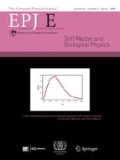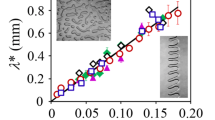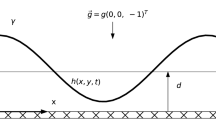Abstract
We study the stability of a viscoelastic thin polymer film under two destabilization factors: the application of an electric field normal to the surface --as in typical electro-hydrodynamic destabilization experiments- and the presence of a frozen-in internal residual stress, stemming from the preparation process of the film, typically spin-coating. At the film-substrate interface we consider a general boundary condition, containing perfect gliding on slippery substrates, as well as perfect sticking of the film to the substrate as limiting cases. We show that the interplay of the two sources of stress, the viscoelasticity and the boundary condition, leads to a rich behavior, especially as far as the fastest growing wave number (or wavelength) is concerned. The latter determines the initial growth of the instability, and often also the final pattern obtained in small capacitor gaps, and is the main experimental observable.
Graphical abstract

Similar content being viewed by others
References
G. Reiter, Adv. Polym. Sci. 252, 29 (2013).
R. Blossey, Thin Liquid Films: Dewetting and Polymer Flow (Springer, Dordrecht, 2012).
S.G. Croll, J. Appl. Polym. Sci. 23, 847 (1979).
K. Norrman, A. Ghanbari-Siahkali, N.B. Larsen, Annu. Rep. Prog. Chem., Sect. C 101, 174 (2005).
G. Reiter, M. Hamieh, P. Damman, S. Sclavons, S. Gabriele, T. Vilmin, E. Raphaël, Nat. Mater. 4, 754 (2005).
H. Bodiguel, C. Fretigny, Eur. Phys. J. E 19, 185 (2006).
D.R. Barbero, U. Steiner, Phys. Rev. Lett. 102, 248303 (2009).
J.Y. Chung, T.Q. Chastek, M.J. Fasolka, H.W. Ro, C.M. Stafford, ACS Nano 3, 844 (2009).
K. Thomas, U. Steiner, Soft Matter 7, 7839 (2011).
M. Chowdhury, P. Freyberg, F. Ziebert, A.C.M. Yang, U. Steiner, G. Reiter, Phys. Rev. Lett. 109, 136102 (2012).
T. Vilmin, E. Raphaël, Eur. Phys. J. E 21, 161 (2006).
F. Ziebert, E. Raphaël, Phys. Rev. E 79, 031605 (2009).
E. Schäffer, T. Thurn-Albrecht, T.P. Russell, U. Steiner, Europhys. Lett. 53, 518 (2001).
J. Sarkar, A. Sharma, V. Shenoy, Phys. Rev. E 77, 031604 (2008).
G. Tomar, V. Shankar, A. Sharma, G. Biswas, J. Non-Newtonian Fluid Mech. 143, 120 (2007).
L.F. Pease III, W.B. Russel, J. Non-Newtonian Fluid Mech. 102, 233 (2002).
F. Closa, F. Ziebert, E. Raphaël, Phys. Rev. E 83, 051603 (2011).
F. Closa, F. Ziebert, E. Raphaël, Math. Model. Nat. Phenom. 7, 6 (2012).
K. Thomas, A. Chenneviere, G. Reiter, U. Steiner, Phys. Rev. E 83, 021804 (2011).
The small conductivity of a polystyrene melt, σ ∝ 10−18 Ω−1m−1 leads to characteristic times for the displacement of charges of around ε/σ ∝ 106 s where ε ≃ 2.5ε 0 is the permittivity. Hence charge displacements can be neglected during the growth of the instability.
J.R. Melcher, G.I. Taylor, Annu. Rev. Fluid Mech. 1, 111 (1969).
Y. Tsori, Rev. Mod. Phys. 81, 1471 (2009).
C.W. Macosko, Rheology: Principles, Measurements, and Applications (Wiley, New York, 1994).
To first order in height perturbation, the convective nonlinearities do not play a role.
G. Tomar, V. Shankar, S.K. Shukla, A. Sharma, G. Biswas, Eur. Phys. J. E 20, 185 (2006).
L.D. Landau, E.M. Lifshitz, Theory of Elasticity (Pergamon Press, New York, 1986). .
P.G. de Gennes, Langmuir 18, 3413 (2002).
M. Behr, Int. J. Num. Meth. Fluids 45, 43 (2004).
X.H. Pan, S.Q. Huang, S.W. Yu, X.Q. Feng, J. Phys. D: Appl. Phys. 42, 055302 (2009).
J.D. Jackson, Classical Electrodynamics (Wiley, New York, 1998).
A. Onuki, Physica A 217, 38 (1995).
A. Ghatak, M.K. Chaudhury, V. Shenoy, A. Sharma, Phys. Rev. Lett. 85, 4329 (2000).
V. Shenoy, A. Sharma, J. Mech. Phys. Solids 50, 1155 (2002).
Note that in case of ρ = 0, i.e. without inertia, l = k and the solution of eq. (15) reads ũ z = A 1 cosh[k(z + h 0)] + A 2(z + h 0) cosh[k(z + h 0)] + B 1 sinh[k(z + h 0)] + B 2(z + h 0) sinh[k(z + h 0)].
Note that all coefficients are ∝ h, hence Z(k, s) does not depend on h.
R. Fetzer, M. Rauscher, A. Münch, B.A. Wagner, K. Jacobs, Europhys. Lett. 75, 638 (2006).
Note that the opposite behavior concerning tension vs. compression has been found for a viscoelastic solid (Voigt-Kelvin model) in fabve.
This effect is related to viscoelasticity, as it was absent in the purely elastic case studied in fabien.
M.C. Cross, P.C. Hohenberg, Rev. Mod. Phys. 65, 851 (1993).
M. Grinfeld, Sov. Phys. Dokl. 31, 831 (1986).
R. Asaro, W. Tiller, Metall. Trans. A 3, 1789 (1972).
Author information
Authors and Affiliations
Corresponding author
Rights and permissions
About this article
Cite this article
Closa, F., Raphaël, E. & Ziebert, F. Electro-hydrodynamic instability of stressed viscoelastic polymer films. Eur. Phys. J. E 36, 124 (2013). https://doi.org/10.1140/epje/i2013-13124-x
Received:
Accepted:
Published:
DOI: https://doi.org/10.1140/epje/i2013-13124-x




